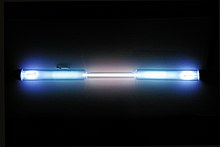Krypton
Krypton is a stable noble gas. It has an atomic number of 36. The name krypton comes from the Greek word kryptos meaning hidden. It is used in fluorescent lamps, flashbulbs, and as a wavelength standard. The metre used to be defined as 1,650,763.73 wavelengths in a vacuum of krypton gas.[1]

Chemistry
changeBecause it is a gas, it does not react with many elements. It is clear and has no taste or smell.[2] The atmosphere is only about one millionth part krypton.[2] Krypton has very few compounds.
Uses
changeThe main use for krypton is to make light. There is one main type of krypton light bulbs. This is called a gas discharge lamp. There are three main types of these. First is a low energy gas discharge lamp or "neon light". Low energy gas discharge lights made from krypton are near white to green. Second is a high energy short length of time gas discharge light or "flash bulb". These are mostly used for photography. They are bright blue-white. Third is a high energy gas discharge light. This third kind is mostly used to light airport runways. They are also bright blue-white.
History
changeKrypton was found by Sir William Ramsay and Morris Travers in Great Britain in 1898.[3] Ramsay was given the 1904 Nobel Prize in Chemistry for his work on noble gases.[4] It was a difficult gas to discover; Ramsay suspected it existed but only found it by removing other gases.[5] This is why he gave it the name Krypton.[5] There is no mineral called Kryptonite or planet called Krypton, which both feature in the Superman comics by Jerry Siegel and Joe Shuster.[5] The fictional planet is probably better known than the real chemical element called Krypton.[5] It took until 1962 until a chemical compound containing Krypton was found.[6]
Related pages
changeReferences
change- ↑ "WebElements Periodic Table of the Elements". webelements.com. 2011. Retrieved 17 June 2011.
- ↑ 2.0 2.1 "Krypton". Academic Press Dictionary of Science and Technology. 2006. Retrieved 17 June 2011.
- ↑ Friend, John Newton (1914). A text-book of inorganic chemistry, Volume 1. Griffin & Company. p. 346. Retrieved 17 June 2011.
- ↑ James, Laylin K. (1993). Nobel laureates in chemistry, 1901–1992. Chemical Heritage Foundation. p. 23. ISBN 0841226903. Retrieved 17 June 2011.
- ↑ 5.0 5.1 5.2 5.3 Alfred, Randy (30 May 2008). "May 30, 1898: Krypton Discovered, Decades Before Superman Arrives". wired.com. Retrieved 29 June 2011.
- ↑ John F. Lehmann, Hélène P. A. Mercier, Gary J. Schrobilgen: The chemistry of krypton. In: Coordination Chemistry Reviews. 233/234, 2002, S. 1–39, doi:10.1016/S0010-8545(02)00202-3.